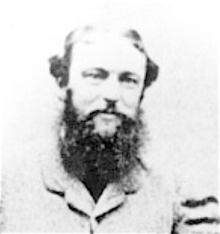
Thomas Jeckyll was born Thomas Jeckell in Wymondham, near Norwich, Norfolk, England in 1827. Nothing is known about his training as an architect. His father was a curate at Abbey Church in Wymondham. He established a practice in Norwich and church restoration was an important part of his early work. By 1854 he had an office on Unthank Road in Norwich. By the late 1850s or early 1860s he had moved his practice to London and in 1868 his office was located at 11 Gloucester Road, Kensington, London.
Initially Jeckyll was a Gothic Revivalist, however, by the 1860s he had embraced Aestheticism and before long was acknowledged as one of the leading figures in the Anglo-Japanese Aesthetic movement in Britain. He made his mark in the new style with the interior he designed for 1 Holland Park, London, the home of the collector, Constantine Alexander Ionides (1833-1900). He also designed a dining-room at 49 Princes Gate, London for the shipowner and art collector Frederick Richards Leyland (1831-1892) in 1876. The room featured copious shelving to display Leyland's extensive collection of Chinese porcelain. It subsequently became known as the ‘Peacock Room’ after the walls were over-painted with decorations by James McNeill Whistler (1834-1903).
In 1859 Jeckyll began a long association with the iron founder Bernard, Bishop & Barnard of Norwich which lasted until the mid-1870s. Over the years he designed a wealth of decorative ironwork for the company including fireplace surrounds, grates, railings, gates and other decorative ironwork. Examples of ironwork he designed for Bernard, Bishop & Barnard featured in the firm's pavilion at the International Exhibition in London in 1862, notably the Norwich Gates. For the company's presence at the Centennial Exhibition in Philadelphia in 1876, he designed a cast- and wrought-iron pavilion.
Jeckyll designed a number of pieces of furniture, usually in the Anglo-Japanese style. Some of the pieces wee commissioned by Ionides.
Towards the end of his life Jeckyll suffered a complete mental collapse and spent his last years in Heigham Hall, a private asylum in Norwich, and in Bethlem Asylum in Norwich. He died in 1881.
A biographical file on Thomas Jeckyll is available on request at the Enquiry Desk, Royal Institute of British Architects Library, London.
Arbuthnott, Catherine and Soros, Susan Weber. Thomas Jeckyll: Architect and Designer, 1827-1881 New York, NY: Bard Graduate Center for Studies in the Decorative Arts, Design, and Culture, 2003
Burke, Doreen Bolger, et al. In Pursuit of Beauty: Americans and the Aesthetic Movement New York, NY: Metropolitan Museum of Art, 1986
Exhibition of Victorian and Edwardian Decorative Arts. Catalogue. London: Her Majesty’s Stationery Office, 1952 p. 57
Fischer, Cynthia. Thomas Jeckyll, James McNeill Whistler, and the Harmony in Blue and Gold : The Peacock Room: A Re-Examination. Ph.D. thesis, Virginia Commonwealth University, 2013
Girouard, Mark, Sweetness and Light: The Queen Anne Movement 1860-1900 Oxford: Clarendon Press, 1977
Hartop, Christopher. ‘Aesthetic mover & shaper’. [Review of an exhibition on Thomas Jeckyll at the Bard Graduate Center, New York in 2003] Country Life vol. 197, no. 39, 25 September 2003, p. 134
Japan and Britain : an aesthetic dialogue 1850-1930, edited and with texts by Tomoko Sato and Toshio Watanabe; with essays by Hugh Cortazzi, Shuji Takashina and Ellen P. Conant. London : Lund Humphries in association with Barbican Art Gallery and the Setagaya Art Museum, 1991
Lange, Alexandra. ‘Exhibitions: Thomas Jeckyll: architect and designer’. [Review of an exhibition on Thomas Jeckyll at the Bard Graduate Center, New York in 2003] Journal of the Society of Architectural Historians vol. 63, no. 2, June 2004, pp. 223-224.
‘Obituary’ Building News vol. 41, 16 September 1881, p. 378
‘Obituary’ British Architect vol. 16, 23 September 1881, pp. 471-472